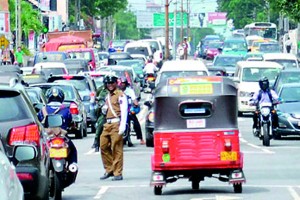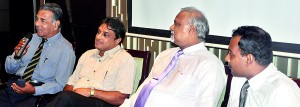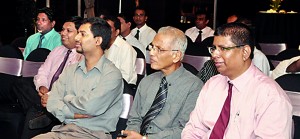Better public transport key to reducing city traffic congestion, experts say
Sri Lanka incurs a huge economic loss of around Rs. 40 billion annually due to road traffic congestion and air pollution with too many vehicles on a limited road network.

File pic by Hasitha Kulasekera shows city traffic on a week day
Unless the authorities take measures to modernise and improve public transport, the country cannot curb this massive, unproductive cost, noted University of Moratuwa transport and logistics management expert Amal S. Kumarage.
Speaking at an interesting discussion on traffic issues including road management and the Colombo road network on Tuesday organised by the Sunday Times Business Club(STBC), Prof. Kumarage stressed the need to implement a pro -public transport policy because the widening of roads and building expressways, elevated highways and/or flyovers will not provide solutions to urban transport problems although it may solve isolated individual problems.
He noted that it is essential to make the shift from private to public transport to tackle the problem of congestion due to the increase in vehicles. When the average speed decreases, it leads to longer travel times, causing an economic loss as a result of high fuel consumption and rise in pollution levels.
However he pointed out that there was no development evident during the past three decades in the public and private bus service and it has gone from bad to worse. The train service – the other possible option – was not even considered by the authorities as yet.
Roads are full with traffic congestion as an average 250,000 vehicles, made up of 15,000 buses, 10,000 trucks and 225,000 private vehicles, enter Colombo daily.
Around 2.7 million vehicles are on the roads, though the number of vehicles registered was over 4.4 million vehicles.
According to statistics a large number of Sri Lankans spend more time on the roads, paying more for fuel, as the number of vehicles on the roads is rapidly increasing and it takes longer to reach one’s destination.
Private companies incur at least 10 percent loss due to heavy fuel bills and in addition they suffer man hour losses as well due to a decline in productivity even after providing vehicles for some of their top executives, he revealed.

Panellists from left: Camillus Abeygunawardene, Amal Kumarage, Rohan Abeywickrema and Chathuranga Perera (STBC President). Pix byRanjit Perera
According to latest statistics there are 130 vehicles per 1,000 people, out of which 66 per cent would be motor cycles while three-wheelers and four-wheelers (small and large) make up 45 vehicles per 1,000 people.
If there is no vehicle fleet management, like in the last 30 years, there will be problems regarding space, he said.
He suggested that there should be a restriction on ownership of vehicles, like in Singapore, where a vehicle permit is auctioned on a quota basis by courts, which will be more expensive than a vehicle.
Permit holders are not allowed to drive their vehicles wherever they wish. A toll is payable, while a vehicle should carry a minimum number of passengers, he disclosed. “Singapore has a stringent traffic management policy which restricts vehicle ownership and they invest heavily on upgrading the public transport system,” he revealed.
He said that with an 8 per cent economic growth anticipated, vehicle growth will be around 10 per cent when capacity can only expand by say 3 per cent per annum and this will be worse than a spike and it will remain at 10 per cent which will be a permanent surge, he said.
He noted that the demand for road space will increase rapidly. Currently Sri Lanka has a vehicle population of around 4 million. “If we expect the economy to grow at 8 per cent, the country’s vehicle population may increase to 5 million,” he said adding that there will be 250 vehicles per 1,000 people which are likely to be concentrated around the city.
Sri Lanka can impose different car restraint policies, but alternatives should be available. Park & Rides, bus lanes, cycle ways, improved transit, etc are options used by other cities very successfully, he added.
Citing an example, he said that traveling in Singapore is both easy and economical. There is an efficient public transportation network, which offers taxis, buses, and the modern Mass Rapid Transit (MRT) rail system.
He said the ad hoc construction of flyovers and highways would not provide a proper solution to the prevailing conditions of heavy traffic in the city of Colombo. Citing an example of a one way system which has shifted the congestion to other areas, he said the Baseline road in Dematagoda which had two lanes before was made into six lanes to reduce traffic.
“Traffic at the Baseline road has increased after being made into six lanes more than what it was with two lanes due to more vehicles on the road and no proper traffic plan,” Prof. Kumarage said.
He noted that a proper town plan, friendly public transport facilities and a sufficient operational traffic system is needed to resolve the current congestion in the Colombo city by creating friendlier public space with new metro systems, public transport terminals and bus traffic trunk systems, like the city of Bogota.
A bus rapid transit (BRT) solution could be implemented faster and at a much lower cost to prevent gridlock in Sri Lanka’s capital Colombo.
The state has been investing heavily in building a road network in recent years, but urban congestion cannot be solved by roads alone, he said, adding that several high ways in the North including Vavuniya had been rebuilt but are used by few motorists and a small number of pedestrians.

Section of the audience.
Such infrastructure development will not help the country any way, he said adding that the traffic problem in Battaramulla area will become a major issue with construction of Defence headquarters following the US pentagon style.
Rohan Abeywickrema, Past President of Institute of Transport and logistics Management, pointed out that this is the time that a new measure and concept of vehicle restraint measures or demand management measures have to come in where the limited road space is managed, leading to efficient traffic management.
The Sri Lanka railway system covering almost all parts of the country should be modernised and popularised providing necessary parking facilities for vehicles and easy access for buses in order to operate a combined transport service.
Camillus Abeygunawardena, Retired DIG – who served as the Head of Traffic Police for a considerable period, said that the police have found it difficult to handle traffic in a fair manner due to political interference and break down in law.
The other main reason was the lack of proper training for newly recruited traffic policemen.
Unless these matters are rectified, it is difficult to streamline the traffic control by the Police, he said.
The club is sponsored by Etisalat, hosted by Cinnamon Lakeside and supported by Hameedia. The STBC is fostered and developed by the Sunday Times to guide young business leaders of today. It has a membership of over 50 many of who are young Managing Directors, CEOs and corporate executives.
Follow @timesonlinelk
comments powered by Disqus


